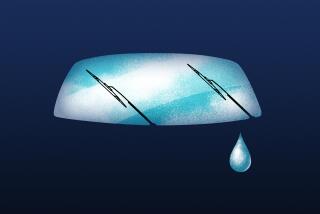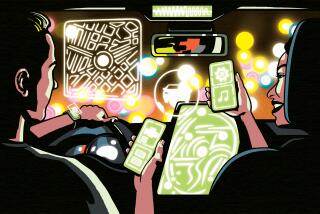Digital Audio Revolution Speeding Toward Cars
Nearly four years ago, Microsoft Corp. honcho Bill Gates wowed the International Consumer Electronics Show with a new computer-powered car audio system called AutoPC.
Some were impressed by the features, such as the voice-activated maps and address book. But others were stunned by the thought of people putting Windows in their cars.
As it turns out, not many did. But Gates wasn’t completely wrong--he just missed the target.
“There is going to be a computer in the car,” said Andrew Wolfe, chief technical officer of Sonicblue, “and the killer app is entertainment. It’s not Web access.”
Sonicblue is one of a wave of companies bringing computer software and hard drives to car audio systems. Others are introducing car disc players that can handle MP3-encoded CDs or DVDs. Consumers also can find car stereos that read flash memory cards and other digital media loaded with songs from their home PCs.
In short, the digital audio revolution that has swept PCs and portable devices is finally coming to cars, thanks to a new generation of smarter car stereos.
The catch is that the revolution is still chaotic. There’s no clear winner among the competing audio formats or portable media.
Most car-audio manufacturers are betting on the lowest common denominator of formats, MP3, which is popular with consumers but not with major record labels and their distribution partners.
As a consequence, not all of the songs that consumers amass on their personal computers will be compatible with the new breed of car stereos.
Have Music, Will Travel
MP3 is a compressed audio format that can squeeze 10 to 12 albums’ worth of material onto a single CD without a significant loss of sound quality. Similar or better results come from its competitors, which include Microsoft’s Windows Media Audio, Sony’s ATRAC3, the Advanced Audio Coding format licensed by Dolby Laboratories and MP3Pro from Thomson Multimedia and Coding Technologies.
That kind of compression makes it possible to cram 1,000 or more CDs onto a hard drive smaller than a paperback book. Put one of those babies in your car, and your entire CD collection will travel with you wherever you go.
The problem is you may not be able to afford it. Hard-drive-equipped car systems start at $600 and go as high as $2,000.
“It’s a wonderful technology,” said Stephen Witt, a marketing vice president at Alpine Electronics of America Inc. “However, to get a hard drive that has the kind of reliability and meets the requirements [of a car system], it’s brutal. It’s like $450.”
And that’s just for the parts.
The price will surely fall over time. But the huge capacity of these drives presents another problem: How do drivers find the songs they want to hear without taking their eyes off the road?
No one’s going to search through hundreds of CDs and assemble playlists at 60 mph (and if they do, you wouldn’t want to be on their side of the median). Nor is the one-or two-line display of the typical car stereo very helpful when dealing with list of thousands of songs.
Daniel Benyamin, a co-founder of PhatNoise Inc., says the solution is for consumers to make playlists for their car stereos on a computer, not in a car. Later this month, PhatNoise plans to sell an add-on unit for car stereos that features a removable 20-gigabyte hard drive. The drive plugs into a docking station that’s attached to a computer, where users can load and organize tracks and create playlists.
PhatNoise’s list price is expected to be just under $800. The company also has a 10-GB model coming from Visteon Corp., which supplies car stereos for several major car manufacturers, early next year. No price has been disclosed for that model yet.
The PhatNoise box is designed to plug into a car audio system as if it were a CD changer. Though the six buttons found on the typical car stereo might be ideal for a six-CD changer, they aren’t a good fit for a hard drive holding scores of playlists and hundreds of albums. That’s why PhatNoise plans to give its products an electronic voice so they can help users find their way around their on-board collection, Benyamin said.
Sonicblue used to sell a hard-drive-equipped system called the Rio Car for $1,200 to $2,000. But its focus has shifted to building units that will be marketed by other companies, including Visteon and the auto makers.
Wolfe said the company plans to start in luxury cars with larger screens than the Rio Car’s four-line display--for example, a postcard-size LCD screen that also could be used for electronic maps. “Right now, we’re really focused first on the systems that can provide a really good experience, and that’s going to add a little bit of cost,” he said.
The company is working on voice-recognition technology that would let drivers choose songs with spoken commands, he said. Although voice recognition is interesting, Wolfe said, “we don’t know how important it is yet.”
The number of manufacturers building hard drives into their car audio products is small but growing. The biggest player so far is Visteon, but consumer-electronics giant Sony may announce one at the Consumer Electronics Show in January. Said Steve Haber, vice president of marketing for mobile electronics at Sony, “We think that a hard drive for a car is a perfect idea.”
Using CD Players
Another, more popular trend among makers of car audio systems is CD players that can read home-recorded discs packed with MP3 files. Seemingly every major name in car stereos has an MP3 CD player on the market, with prices ranging from $200 to $600. Some can read DVDs as well, either for navigation or entertainment.
Although the disc players tend to be much less expensive than hard-drive units, they’re also less adaptable. The software on a removable hard drive can be updated automatically whenever the drive is plugged into a computer to grab more songs.
With a disc player, consumers would have to download the new software, record it onto a disc, insert the disc into their player and cross their fingers. Any mistakes on the disc or in the downloaded program could render the player inoperable.
Adaptability is important because compressed music formats are still in flux. There’s competition and evolution not only among the different types of compression but also in the software used to scramble compressed files to prevent piracy.
On the other hand, consumers may reject the major record labels’ attempts to apply electronic locks to the music they buy, and MP3 may emerge as the people’s choice for compression. If that happens, adaptability won’t be as important as circuitry to pump up the sound quality.
What consumers really want, Sony’s Haber says, is a car stereo that can handle all of the media on which they store their music. Sony’s product line includes jack-of-all-trades units that can handle three plug-in modules: a CD changer, a MiniDisc changer and a Memory Stick reader.
Although other manufacturers may not be so keen on Sony’s MiniDisc or Memory Stick formats, they are building more car stereos capable of handling multiple add-ons. For example, some offer units that can play MP3 CDs and read flash memory cards, or play MP3 CDs and link to a hard drive.
Meanwhile, the manufacturer of the in-dash AutoPC receiver, Clarion Corp. of America, has dropped the product after selling only about 1,000 units. Instead, Clarion has incorporated many of the AutoPC’s features into its new, entertainment-focused Joyride unit, due in January.
The voice-activated Joyride will play CDs, MP3 CDs and DVDs, with videos appearing on a small LCD screen in the back seat while music plays or maps are displayed up front. But there is no joy in its list price: $2,699 for the basic unit.
*
Jon Healey covers the convergence of technology and entertainment. He can be reached at jon.healey@latimes.com.







